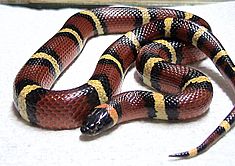 |
| Lowland streaked tenrec |
 |
| Poison dart frog |
Young predators sometimes make the mistake of attacking one of these conspicuous species. If the attacker survives the experience, it learns to avoid them in the future. The system of defense therefore works best against predators who are able to learn.
The coral snake (above) is poisonous venomous, but the harmless milk snake (below) mimics its coloration and derives a benefit.
Aposematic colors in insects are often red, yellow, orange, and black, colors that are can be seen by birds, lizards, and primates, their chief predators. The skunk uses black and white, because that pattern is most noticeable to mammalian predators.
-----
Aposematism on Wikipedia









4 comments:
Thank you for this post. FASCINATING - love those bright colors will have to think about the meaning or not.
My son's dog must not learn well. I can't count the times she has gone out for a pee-pee run and returned having had a full-on encounter with Flower!!! They live deep in the country, lots of critters to chase, but she seems to prefer Flower's perfume!!!!! She will even roll on a dead skunk to adorn herself with its aroma. Perhaps there's a term for what different mammals consider a wonderful scent of perfume?
From time to time i teach science at school and this (and etology in general) is one of the subjects that kids find more interesting! I do a little joke: i show them an hoverfly picture and i ask which animal it is. They usually answer "bee" or "wasp", but soon they realize that there's something wrong. I explain to them that they have just observed their ancient mammal brain in action, since their istinct said to them "yellow and black stripes: danger!" and they answered "bee" or "wasp" without thinking, even if, with a more careful observation, it was pretty easy to understand it was something different (and also evolution is a subject they find really interesting!) . People say that kids only think about their phones, and it's partly true, but when their curiosity is still alive, it just need the right input!
msp, dogs often roll on the corpses of dead animals, i think (if i remember correctly, but i may be wrong) it's something wolves do to mask their smell to not be perceived by preys!
That was a very interesting post. I just have a very minor nitpick - snakes are "venomous" not "poisonous". When a toxin is delivered through bite or sting it is referred to as venom.
Post a Comment